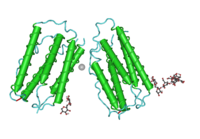
Photo from wikipedia
Fish interferon (IFN)-mediated antiviral innate immunity is the first line of defense against virus invasion. In the present study, we identify two fish IFN genes (here tentatively named IFNa and… Click to show full abstract
Fish interferon (IFN)-mediated antiviral innate immunity is the first line of defense against virus invasion. In the present study, we identify two fish IFN genes (here tentatively named IFNa and IFNc) with different-sized 3' UTRs from clone F strain of gibel carp Carassius auratus gibelio. Carp IFNa has a relatively short 3'UTR without AU-rich elements (AREs) but IFNc has a long one with 9 AREs. Functionally, carp IFNa and IFNc display significantly antiviral potential to viral infection, likely through induction of downstream IFN-stimulated genes (ISGs). Both carp IFN genes are induced by viral infection, poly(I:C) treatment and IRF3/7, which are ascribed to the IFN-sensitive response elements (ISRE) within their promoters. Carp IFN genes are also induced by each other and by themselves, indicating existence of a positive feedback loop in fish IFN-mediated antiviral immune response. Comparative analyses of 3'UTR-mediated expression regulation at mRNA and protein levels show that the ARE-containing 3'UTR of carp IFNc rather than the short 3'UTR of carp IFNa promotes mRNA decay but instead results in high-level protein expression, indicating that 3'UTR of fish IFN mRNAs might be a potential factor for regulation of IFN-mediated antiviral immune response. Considering a fact that a given protein function is largely related to its protein level, these results suggest that both promoter and 3'UTR contribute to the transcription and translation of fish IFN genes, thus shaping their eventually antiviral potential.
Journal Title: Molecular immunology
Year Published: 2020
Link to full text (if available)
Share on Social Media: Sign Up to like & get
recommendations!